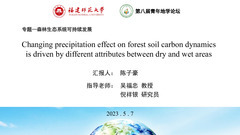报告详情
Changing precipitation effect on forest soil carbon dynamics is driven by different attributes between dry and wet areas
编号:872
访问权限:私有
更新:2023-04-08 23:36:20 浏览:578次
快闪报告
摘要
Changes in precipitation patterns have the potential to significantly affect the global carbon (C) cycle by altering soil organic carbon (SOC) dynamics. Comparing the patterns and drivers of soil C responses to precipitation changes in wet and dry forests can improve our understanding of soil carbon-water coupling. In this study, we conducted a meta-analysis to assess the effects of precipitation changes on soil dissolved organic carbon (DOC), microbial biomass carbon (MBC), SOC concentrations, and carbon dioxide (CO2) flux across a broad range of forest sites in dry and wet regions. The results showed that both the soil DOC and MBC concentrations decreased significantly (by averages of 7.8 and 7.9%, respectively) at the wet sites, but increased (by 1.2 and 10.2%, respectively) at the dry sites under increased precipitation conditions. The soil MBC concentrations decreased by 17.5% at the wet sites but by 4.1% at the dry sites under reduced precipitation conditions. The soil CO2 flux decreased by 18.9% and 14.3% at the wet and dry sites, respectively, under reduced precipitation. The responses of the soil MBC concentrations were influenced by precipitation intensity, whereas soil DOC and SOC concentration, and CO2 flux were regulated by the soil texture and climate. Clearly, soil MBC was more sensitive to increased precipitation at the dry sites than at the wet sites. Under reduced precipitation, changes in soil MBC concentration and CO2 flux were stronger at the wet sites than at the dry sites. To enhance forecasting of soil C cycles and functional alterations in a changing climate, the differing response mechanisms in dry and wet areas should be considered using process-based climate models.
关键词
Precipitation change; Forest soil; Soil organic carbon;
报告人

陈子豪
福建师范大学稿件作者
全部评论
重要日期
-
会议日期
05月05日
2023
至05月08日
2023
-
03月31日 2023
初稿截稿日期
-
05月25日 2023
注册截止日期
主办单位
青年地学论坛理事会
中国科学院青年创新促进会地学分会
中国科学院青年创新促进会地学分会
承办单位
武汉大学
中国科学院精密测量科学与技术创新研究院
中国地质大学(武汉)
中国科学院精密测量科学与技术创新研究院
中国地质大学(武汉)



发表评论